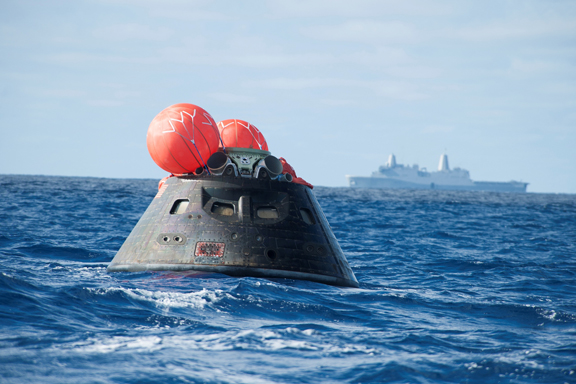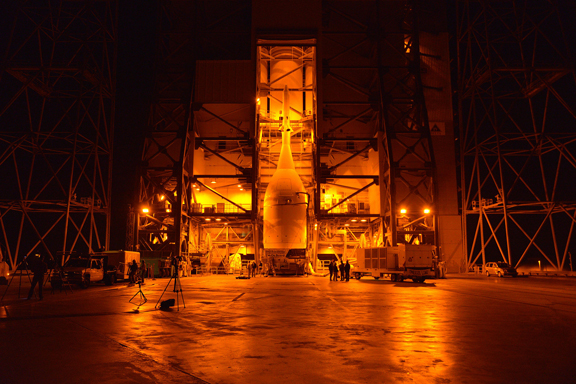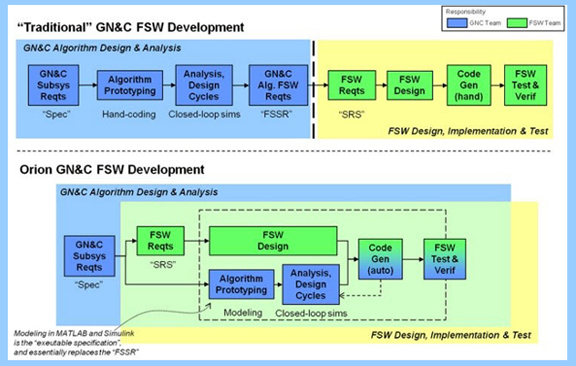
The Orion in the water, awaiting recovery (image courtesy of NASA).
Latest News
March 4, 2015
 The Orion in the water, awaiting recovery (image courtesy of NASA).
The Orion in the water, awaiting recovery (image courtesy of NASA). NASA Orion on its launch pad (image courtesy of NASA)
NASA Orion on its launch pad (image courtesy of NASA)In 1981, Jon Friedman watched the first Columbia space shuttle’s launch from a black-and-white TV screen. Last December, Friedman, now the aerospace manager at MathWorks, was watching the first test flight of NASA Orion from an iPad alongside his kids. Time passes and children grew up, but the passion for space exploration remains the same in the Friedman household.
Friedman has another reason to care about the Orion’s journey. When the Orion finally sets its course for the mythical Red Planet, it will be relying on the guidance, navigation, and control (GN&C) software developed in partnership with MathWorks to get there.
“I want to congratulate the engineers at NASA, Lockheed Martin, Draper Laboratory who made it work,” said Friedman. “[MathWorks] has always been about accelerating the pace of discovery in engineering and science.”
The Orion project is also an exercise in software development acceleration, made possible by MathWorks MATLAB and SimuLink. Roughly 40,000 lines of code were automatically generated by the process, bypassing the need to schedule manual coding time.
 Comparing model-based design to tradition approach in code generation (image courtesy of MathWorks)
Comparing model-based design to tradition approach in code generation (image courtesy of MathWorks)“Guiding the Orion craft to a splash-down point within a half mile of its chute deploy target required the strengths of the entire team,” explained Mark Jackson, Draper Laboratory’s GN&C integration lead for the NASA team. “By combining Draper’s entry guidance algorithm with the auto-generated code capability of MATLAB and Simulink, the team met NASA’s objectives for landing guidance, navigation, and control.”
Friedman remarked, “With this approach, you don’t have to wait for the best software coders in the team to hand-code the software. The code-generator can easily reproduce code, so when you have a design configuration you like, you can automatically generate the code.”
The GN&C software is critical in the closed-loop simulation of the Orion’s flight. NASA uses the C++ flight code in its flight simulation conducted in Trick, a software-based simulation environment. This approach, MathWorks revealed, allows the apace agency to simulate a full 10-day Orion mission in just one day.
Committing to the model-based design approach meant a steep learning curve for some engineers unaccustomed to the method. “We’ve seen that the return-on-investment for model-based design could be in the range of 100-200% over the lifespan of a program,” remarked Friedman, “because you discover errors earlier, can identify problems with requirements much earlier.”
In software development, the “model” is not a detailed 3D CAD assembly (as the case would be with MBD in manufacturing) but a graphical representation of the dynamic system of the spacecraft. “Simulink Advisor can essentially interrogate the model to make sure it meets your standards, that it doesn’t include certain constructs you don’t want,” said Friedman. “For example, if you decide to permit only linear models of actuators, Simulink can catch the nonlinear models that might have snuck in.”
In mechanical system modeling, engineers may try to push the limits of the design to identify its breaking point by subjecting it to extreme loads and stresses. In software simulation, Friedman explained, “It’s important to verify the model’s coverage, meaning, you make sure you have explored all the different paths the software can take, that you have fully exercised everything.” That task was largely automated in the Orion project using MathWorks’ Simulink Verification and Validation.
Developing the algorithms for the Orion GN&C software involves more than 100 engineers from different organizations; the MBD approach ensures all the works were done in synchronicity without conflicts. According to MathWorks, “Simulink models serve as an executable specification from which flight software is automatically generated. As a result, the domain experts—the GN&C analysts—work directly with the executable algorithm models rather than with documents that must then be interpreted by software developers.”
Friedman quipped that his son is also learning the art of MBD in a class exercise where he and his classmates must model a city block together in Minecraft—without accidentally building highrises on top of one another.
The NASA Orion leadership team is currently on the road in California, with stops planned at the NASA’s Jet Propulsion Laboratory in Pasadena, Aerojet Rocketdyne in Sacramento, and Lockheed Martin’s Sunnyvale facility.
Subscribe to our FREE magazine, FREE email newsletters or both!
Latest News
About the Author
Kenneth Wong is Digital Engineering’s resident blogger and senior editor. Email him at [email protected] or share your thoughts on this article at digitaleng.news/facebook.
Follow DE





